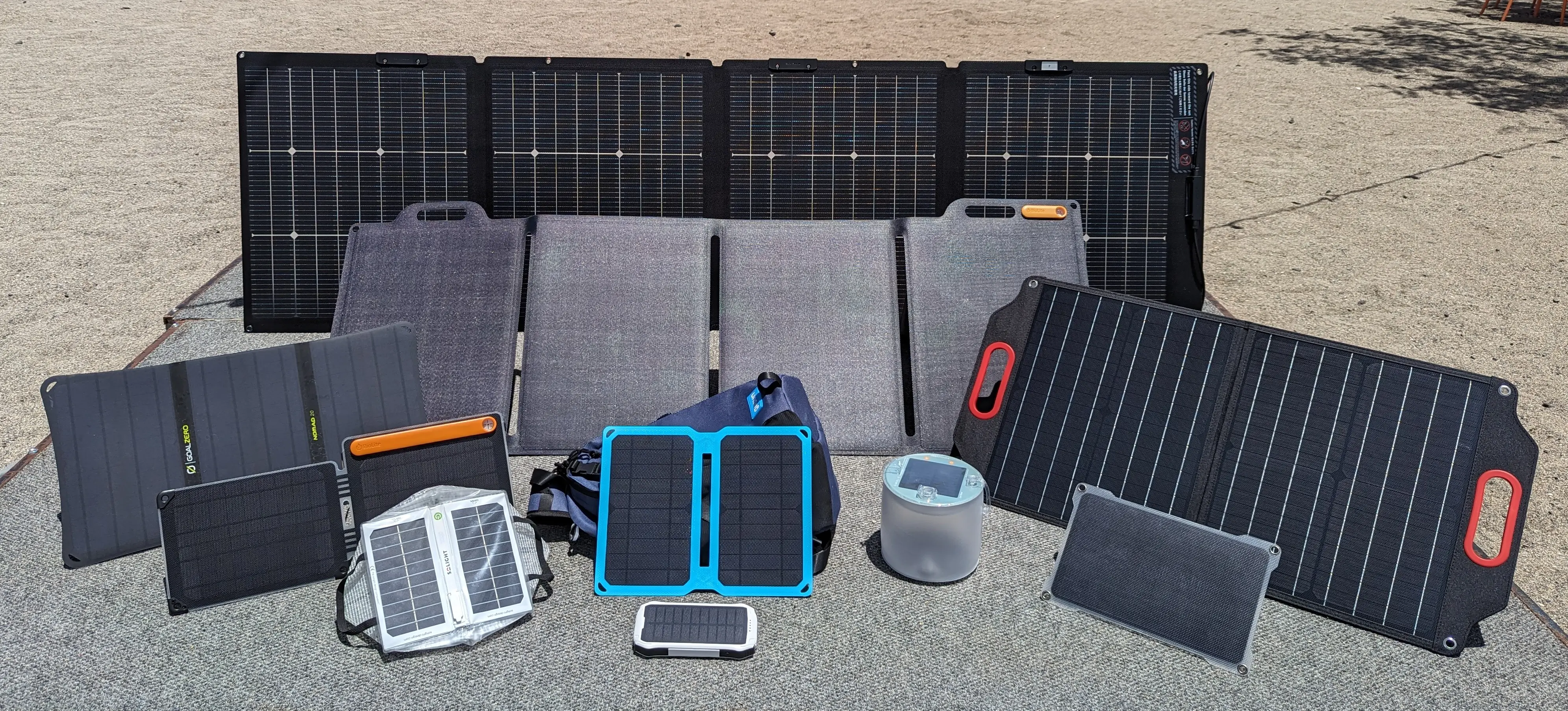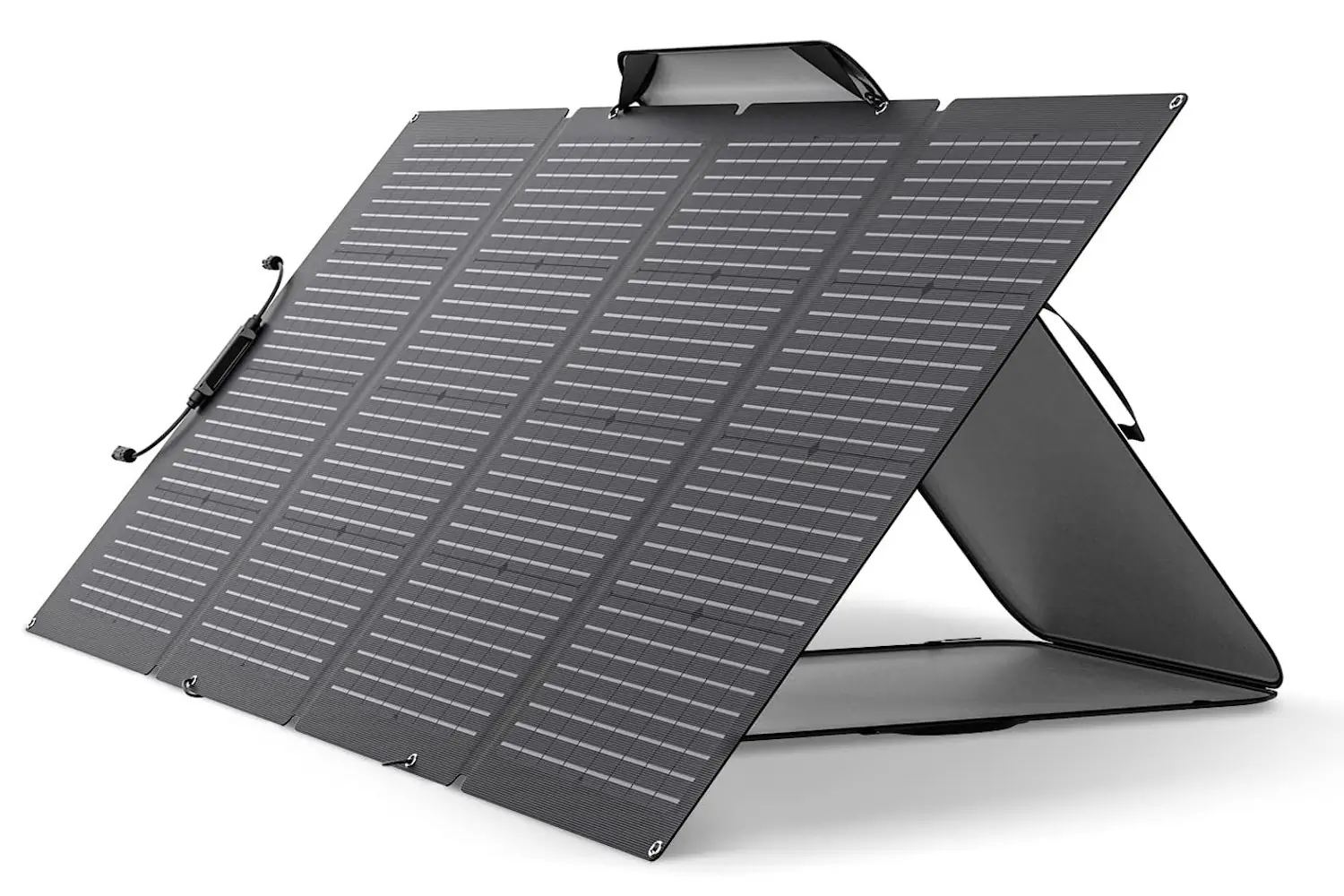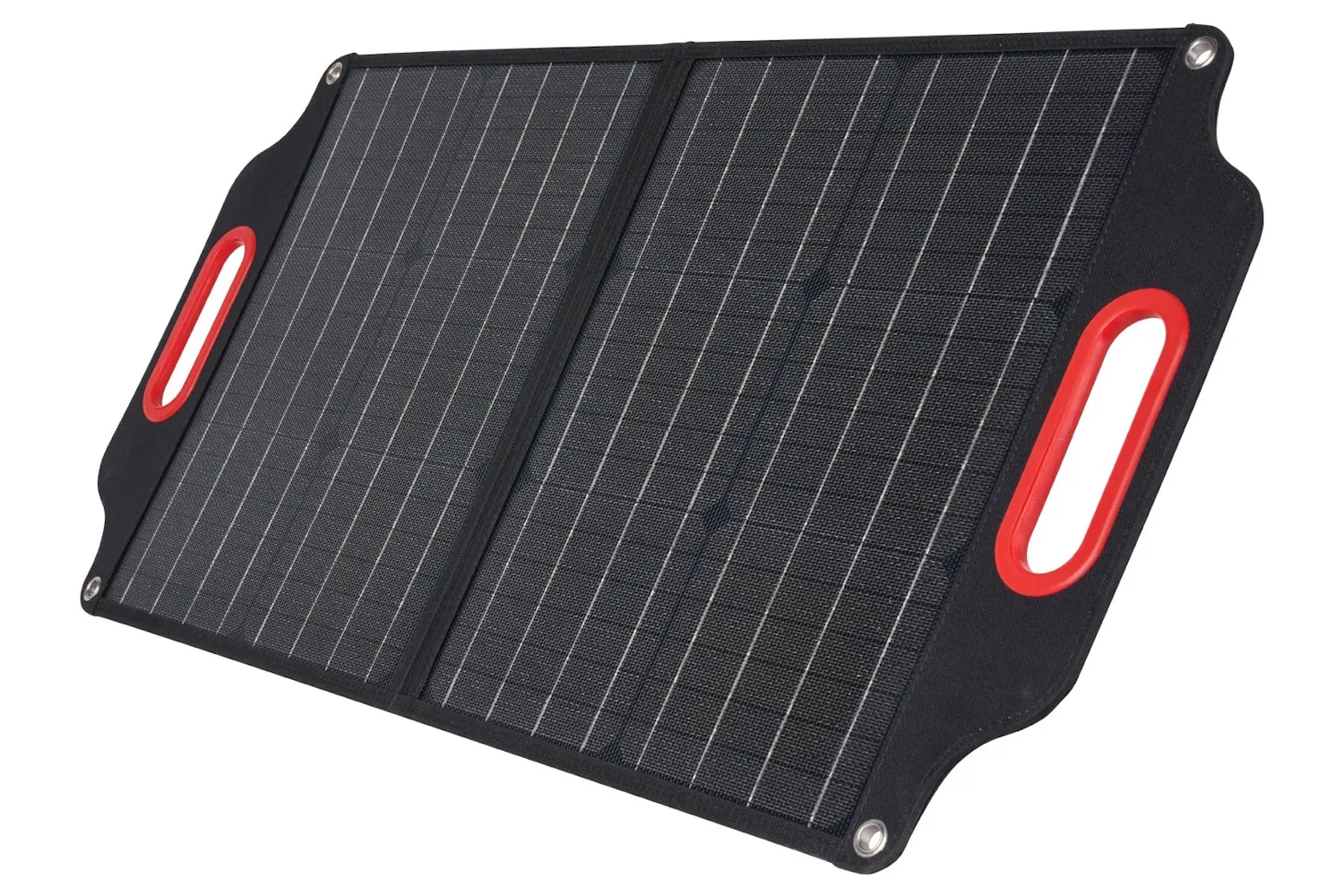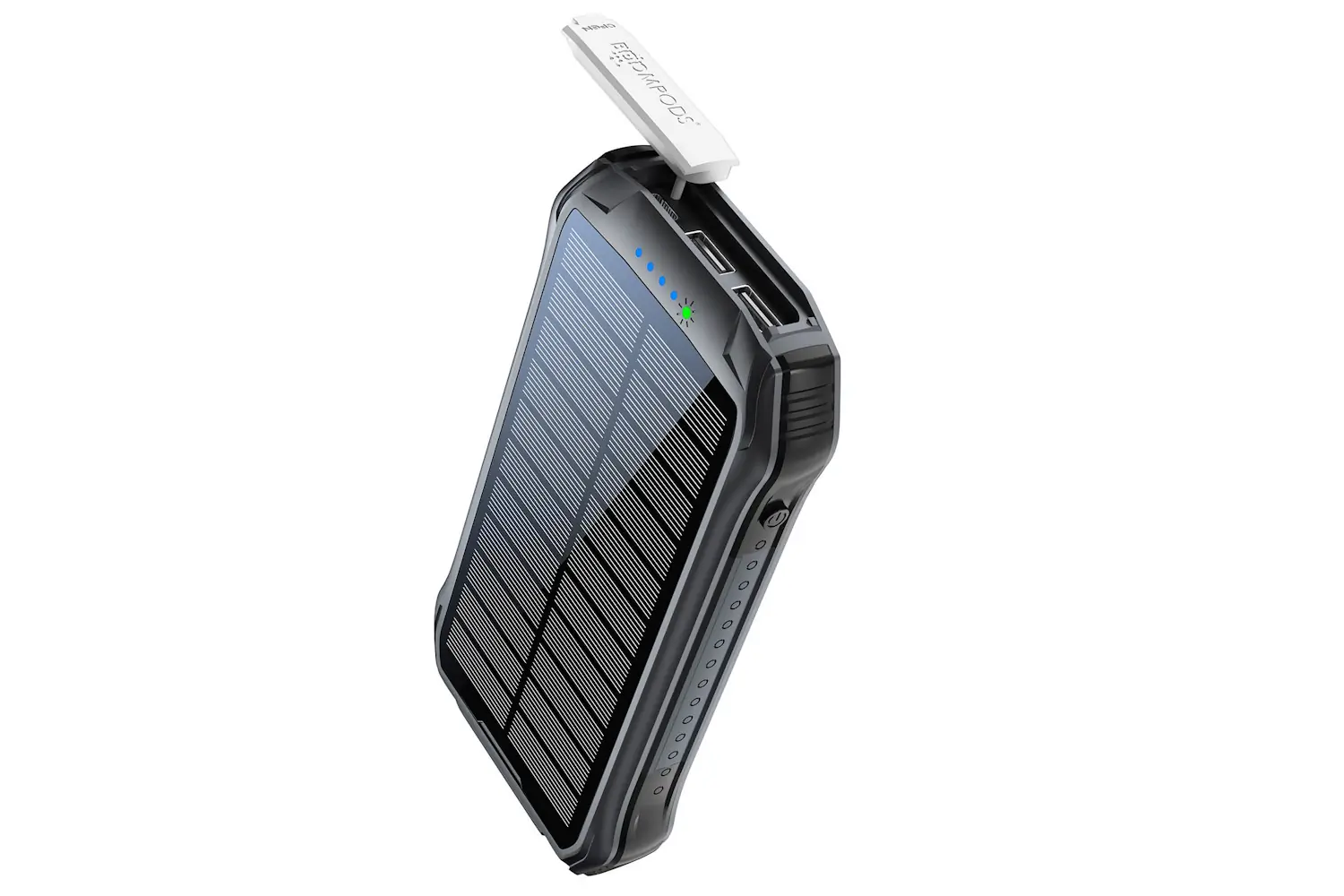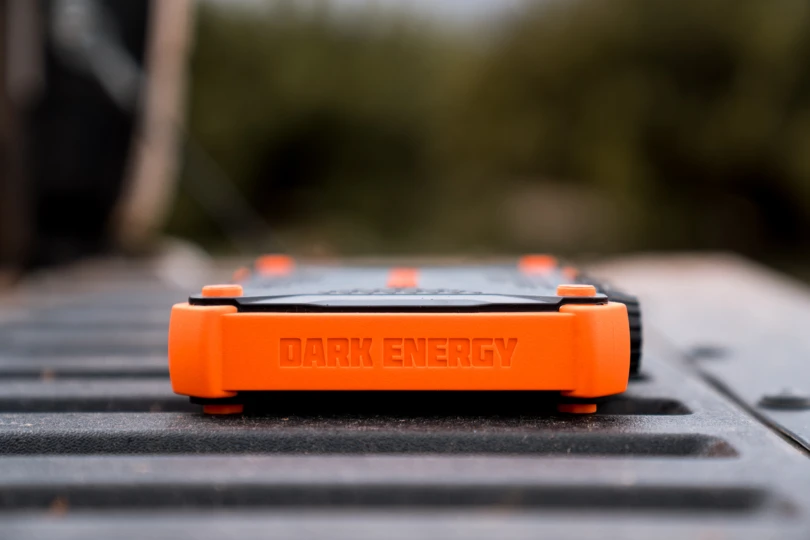Solar chargers are like giant, invisible extension cords that let us power up gadgets wherever we roam. But they don’t just bring life to the devices that fuel our far-flung adventures. The best portable solar chargers free us to focus on the people, places, and activities that truly fill our buckets.
Our experts have been writing about solar panels, charging docks, power strips, batteries, and other trusty travel tech for over 25 years. During that time, charging technology has gotten safer and smarter. Batteries have gotten smaller yet more powerful. Solar panels have become way more commonplace both at home and along the dusty trail.
Specifically for this buyer’s guide, we conducted online research and identified over a dozen portable solar chargers ranging in price from $30 to $649. After careful consideration, we narrowed down the candidates to a handful that we tested in real-world conditions.
Below are the best portable solar chargers based on our testing. To help you find the best charger for your unique needs, we’ve included a Comparison Chart, a Buyer’s Guide, and a Price & Value section.
Editor’s Note: For our November 13, 2024 update, we added a Price & Value section to explain what buyers get at different price points.
The Best Portable Solar Chargers of 2024
EcoFlow 220W Bifacial Portable Solar Panel
- Max Power Output: 220W
- Weight: 20.9 lbs.
- Weatherproof: IP68
- Adjustable Stand: Yes
- Carrying: Waterproof case
- Charging Ports: Integrated DC cables x 2
- Dimensions: 23 x 24.3 x 1.5 in. folded, 72.0 x 32.3 x 1.0 in. unfolded
- Best For: Overlanding, RVing, charging portable power stations
Pros
- Captures sunlight on both sides of the panel
- Tempered glass is thin and durable
- Good price for its size and power
- Panel and carrying case are both waterproof
Cons
- Expensive
- Heavy
- Limited use cases
Outdoor Tech Dawn Solar Panel
- Max Power Output: 40W
- Weight: 4.85 lbs.
- Weatherproof: IPX3
- Adjustable Stand: Yes
- Carrying: Built-in handles, pouch
- Charging Ports: USB-A, integrated cables for USB-C and DC x 2
- Dimensions: 16.2 x 16.2 x 1.6 in. folded, 32.4 x 16.2 x 1.1 in. unfolded
- Best For: Car camping, glamping, general use
Pros
- Plenty powerful for the money
- Magnetically clasping handles makes carrying easy
- Built-in pouch holds charging cords
- Integrated DC and USB-C cables
- Digital readout provides instant info
Cons
- IPX3 leaves it susceptible to dust and rain
- Not able to charge bigger laptops directly
GoSun Solar Panel Backpack
- Max Power Output: 10W
- Weight: 0.65 lbs.
- Weatherproof: N/A
- Adjustable Stand: No
- Carrying: Inside backpack
- Charging Ports: USB-A
- Dimensions: 5.25 x 7 in. folded; 10.5 x 7 in. unfolded
- Best For: Hiking, backpacking
Pros
- Panel is thin and light
- Good power for its size
- Bundle includes several handy accessories
Cons
- Difficult to position
- Panel doesn’t feature a carrying pouch
GoSun Shield
- Max Power Output: 60W
- Weight: 9 lbs.
- Weatherproof: N/A
- Adjustable Stand: Yes
- Carrying: Strap holds together when folded
- Charging Ports: USB-C, USB-A, DC
- Dimensions: 9.5 x 27 in. folded, 56 x 27 in. unfolded
- Best For: Overlanding, car camping
Pros
- Provides shade for car interior
- Able to jumpstart a car
- Can be used away from vehicle
- Multiple charging ports
Cons
- Weak power for its size
- Doesn’t fit in a backpack
Pale Blue Earth Approach Portable Solar Panels
- Max Power Output: 7W
- Weight: 0.68 lbs.
- Weatherproof: IP53
- Adjustable Stand: No
- Carrying: No case
- Charging Ports: USB-A x 2
- Dimensions: 7.9 x 11.8 x 0.8 in.
- Best For: Through-hiking, charging phones and cameras
Pros
- Simple and super lightweight
- Dual USB charging ports
- Built-in cargo storage pouch
- Includes lashing cords
Cons
- Only powers small devices
- Not weatherproof
- Relatively weak for its price
- Max Power Output: 20W
- Weight: 2.28 lbs.
- Weatherproof: IP65
- Adjustable Stand: Yes
- Carrying: No
- Charging Ports: DC, USB-A
- Dimensions: 11.5 x 7.4 x 1.3 in. folded, 11.5 x 21.8 x 0.8 in. unfolded
- Best For: Travel, camping, charging power banks
Pros
- Decent power for its size
- Adjustable stand
- Integrated DC cable
- Flexible charging port
- Works great with external battery
Cons
- Not the strongest value for the price
- No carrying case
- Max Power Output: N/A
- Weight: 0.83 lbs.
- Weatherproof: IPX4
- Adjustable Stand: No
- Carrying: No case
- Charging Ports: USB-A x 2
- Dimensions: 3.3 x 6.7 x 0.9 in.
- Best For: Charging phones and other small devices
Pros
- Compact, durable design
- Inexpensive
- Charges two USB devices at once
- Built-in flashlight
- Available in two colors
Cons
- Small solar panel
- No cables included
- Max Power Output: N/A
- Weight: 0.63 lbs.
- Weatherproof: IP67
- Adjustable Stand: No
- Carrying: Strap
- Charging Ports: USB-C, USB-A
- Dimensions: 6 x 1.5 in. collapsed; 6 x 5.4 in. Inflated
- Best For: Camping, charging phones and other small devices
Pros
- Compact and lightweight
- Decorative and fun
- Up to 50 hours of light
- Waterproof
- USB-A and USB-C charging ports
Cons
- Small solar panel
- Have to inflate to fully use
- Only white light
Best Portable Solar Charger Comparison Chart
| Portable Solar Charger | Max Power Output | Weight | Weatherproof | Adjustable Stand | Carrying | Charging Ports | Dimensions | Best For |
|---|---|---|---|---|---|---|---|---|
| EcoFlow 220W Bifacial Portable Solar Panel | 220W | 20.9 lbs. | IP68 | Yes | Waterproof case | Integrated DC cables x 2 | 23 x 24.3 x 1.5 in. folded, 72.0 x 32.3 x 1.0 in. unfolded | Overlanding, RVing, charging portable power stations |
| Outdoor Tech Dawn Solar Panel | 40W | 4.85 lbs. | IPX3 | Yes | Built-in handles, pouch | USB-A, integrated cables for USB-C and DC x 2 | USB-A, integrated cables for USB-C and DC x 2 | Car camping, glamping, general use |
| GoSun Solar Panel Backpack | 10W | 0.65 lbs. | N/A | No | Inside backpack | USB-A | 5.25 x 7 in. folded; 10.5 x 7 in. unfolded | Hiking, backpacking |
| GoSun Shield | 60W | 9 lbs. | N/A | Yes | Strap holds together when folded | USB-C, USB-A, DC | 9.5 x 27 in. folded, 56 x 27 in. unfolded | Overlanding, car camping |
| Pale Blue Earth Approach Portable Solar Panels | 7W | 0.68 lbs. | IP53 | No | No case | USB-A x 2 | 7.9 x 11.8 x 0.8 in. | Through-hiking, charging phones and cameras |
| GoalZero Nomad 20 | 20W | 2.28 lbs. | IP65 | Yes | No case | DC, USB-A | 11.5 x 7.4 x 1.3 in. folded, 11.5 x 21.8 x 0.8 in. unfolded | Travel, camping, charging power banks |
| BoomPods Neutron Power Bank | N/A | 0.83 lbs. | IPX4 | No | No case | USB-A x 2 | 3.3 x 6.7 x 0.9 in. | Charging phones and other small devices |
| MPowerd Luci + Powerbank | N/A | 0.63 lbs. | IP67 | No | Strap | USB-C, USB-A | 6 x 1.5 in. collapsed; 6 x 5.4 in. Inflated | Camping, charging phones and other small devices |
How We Tested the Best Portable Solar Chargers
Our philosophy at GearJunkie is simple: embrace the gear that gets us outside. In the world of gadgets, that translates into many devices that inevitably require power. So, when it comes to solar technology, we like to keep current.
Our Expert Tester
Leading our testing efforts, Scott Tharler has been writing about consumer electronics for various outlets for over 25 years. Throughout that time, Tharler has attended CES more than two dozen times. Covering power-related products is one of his favorite beats. He met the GoSun guys right when they launched their first solar oven. And first-hand, he’s witnessed wire-free charging tech that promises to power small devices through the air.
Over that same span, it’s become commonplace to see solar technology helping to illuminate our walkways, tech up our campsites, and lower our electric bills. We’re all about it. And we’ll continue to cull and assess additional portable solar chargers for future iterations of this guide.
Looking for more tech? Check out our roundups of the best portable power stations and the best power banks.
Our Testing Process
Throughout several weeks of testing in typical real-world situations, we used a wide variety of portable solar chargers. Some were small novelties, including a power bank and a few lanterns, each clad with solar cells capable of topping off our phones.
Others were varying sizes of dedicated solar panels, with the larger folding variety able to refill an entire portable power station, one of which we also tested specifically for this guide. All that to say, it’s been months since we’ve seen a wall outlet…and our phones haven’t died once.
We conducted our research on the Big Island of Hawaii, no stranger to sunshine. But we also tested on cloudy days and even left the panels out in the occasional rainstorm once or twice. In the end, we rated these products based on such factors as power (relative to price and panel area), ease of use, portability, adjustability, price, and special features.
Buyer’s Guide: How to Choose a Portable Solar Charger
As it turns out, we’re suckers for all power-related products. But it’s especially nice to know that whether tailgating, overlanding, or hiking and camping miles from the nearest vehicle, there’s a power source up in the sky that we can tap into from almost anywhere.
As magical as that may seem, selecting a portable solar charger can certainly be a daunting task. Some are as small as a journal, and others as big as a mattress. They can run under a hundred bucks or into the thousands. And somewhere within that vast range is a solar charger that will power the devices you need. But making an informed decision requires dedicated thought and research.
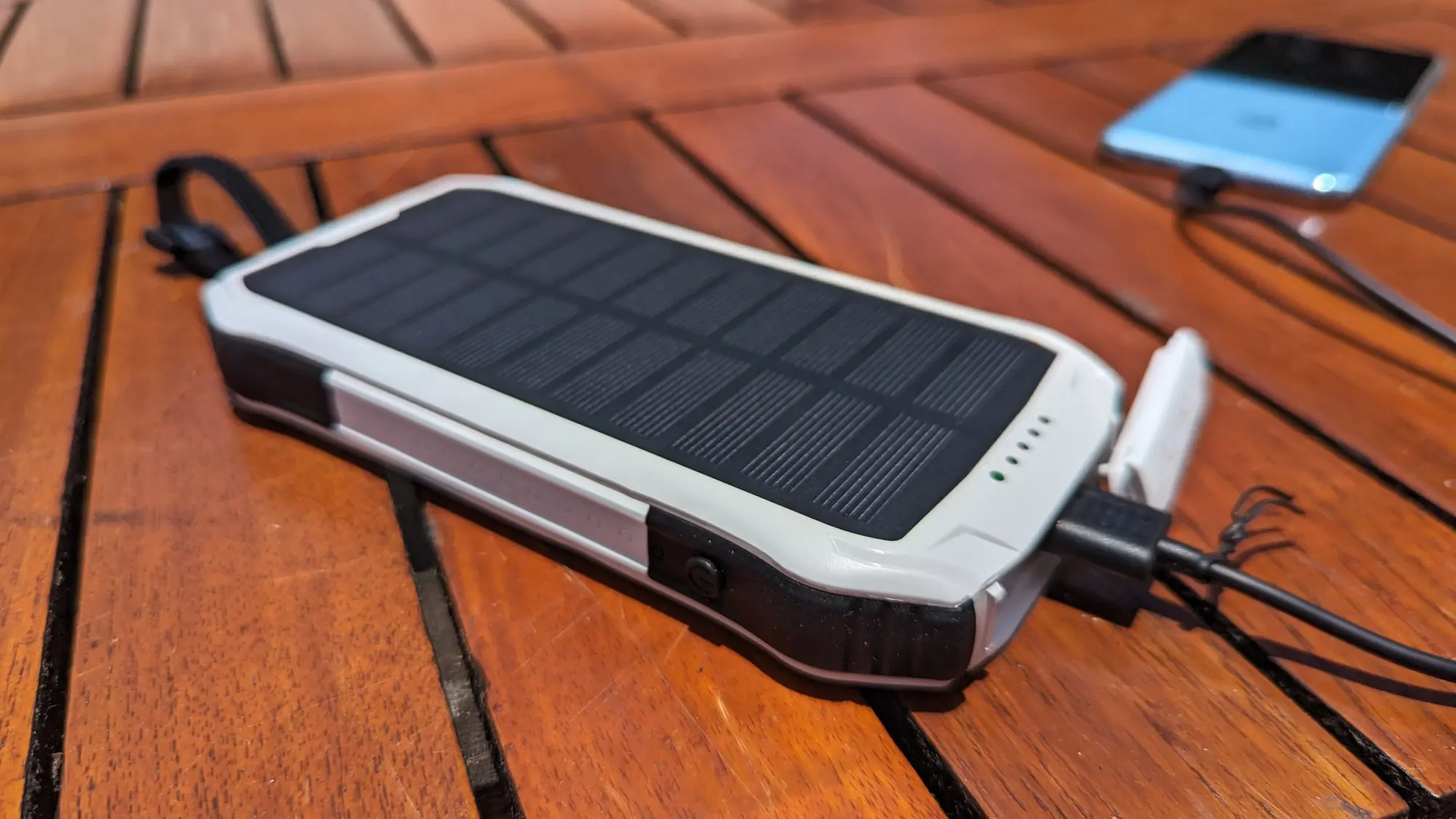
Fortunately, this empowering guide packs all the essential info you’ll need to choose the best portable solar charging solution for you. You’ll learn why you should and shouldn’t consider particular types of portable solar chargers and which features matter most. In a nutshell, it’s everything you need to know about purchasing a portable solar charger that truly deserves its place in the sun.
Power (Wattage)
This number, which often appears in the solar product’s name — as with the EcoFlow 220W Bifacial Portable Solar Panel, GoalZero Nomad 20, and BioLite SolarPanel 10+ — indicates the maximum power in watts that the solar charging system can generate.
By multiplying the average watts generated by the time the panel is exposed to the sun, you can get a sense of how much energy the panel can actually store. For instance, if a 100W panel is able to steadily collect 75 W of power for 4 hours, that’s 300Wh.
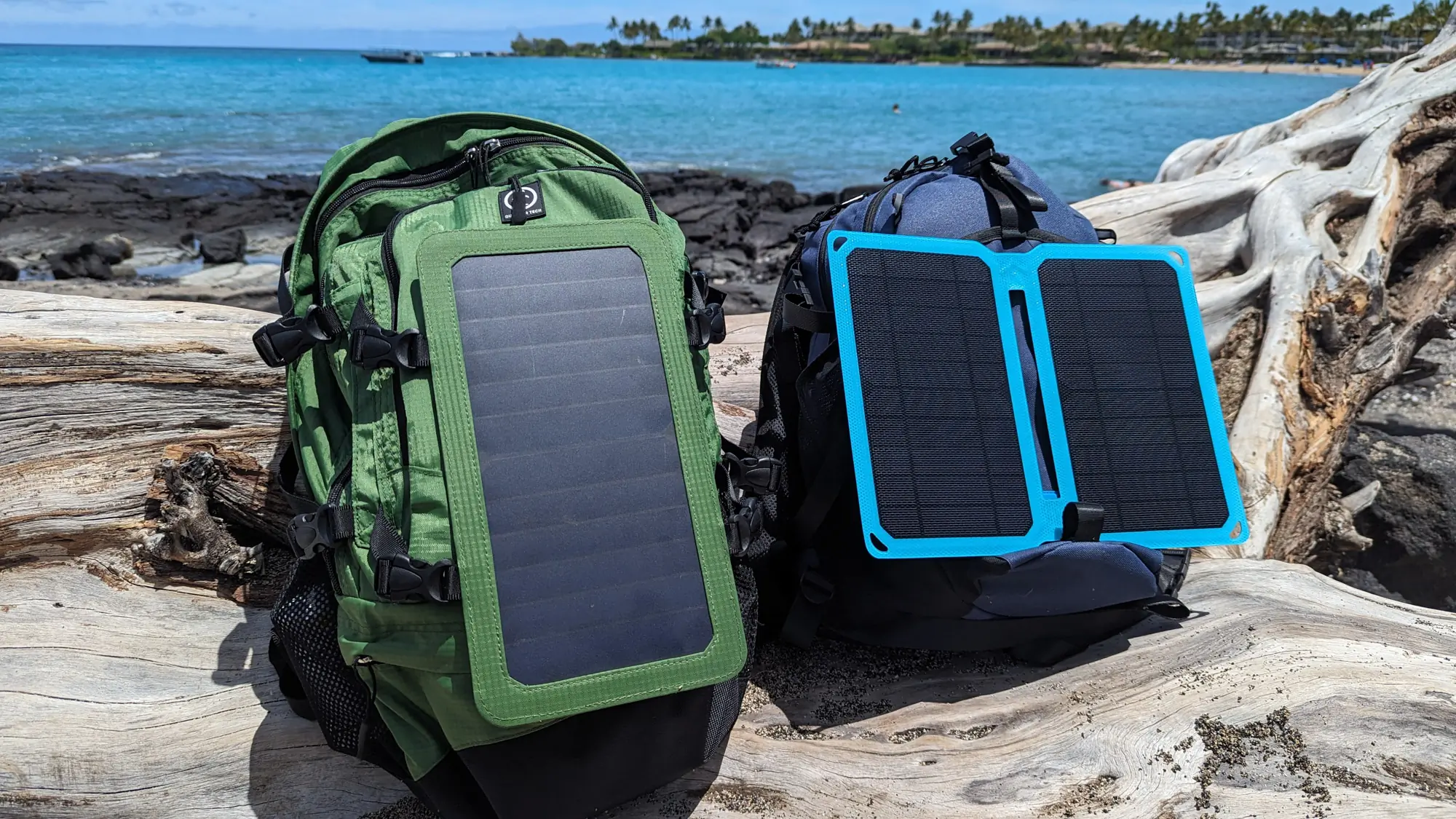



You just need to assess how that matches up against your device charging needs to determine if you need more/bigger panels. Some manufacturers, such as Jackery, offer online tools to help you roughly estimate your needs.
You input your use case and what devices you plan to use, and the calculator relays which solar panel and portable power station options can tackle that many watt-hours. Remember, similar to buying light bulbs, just because you can get more watts for the same price doesn’t mean you should.
The other way to determine your wattage needs is in the reverse, based on how much space you have or how much you want to spend. That is to say, if you’re backpacking, it doesn’t make sense to be looking at a big 100W or 400W system you’ll never want to lug around. Likewise, if you’re overlanding, you probably won’t just need a dainty 10W panel for all the devices you’re carting along.
Furthermore, if your budget maxes out at $200, it doesn’t make sense to eyeball way more expensive systems. So, you should look at solar charging systems based on the factors that are most important to you. If it’s the price, check out our Value pick, the Outdoor Tech Dawn Solar Panel.
And if it’s space, the EcoFlow 220W Bifacial and GoSun Solar Panel Backpack offer the greatest number of watts relative to their respective solar panel areas.
Efficiency
How effectively solar panels convert the sun’s rays into electricity is ever-evolving. Not so long ago, you might have been lucky to get 15-20%. But today’s solar panels can routinely achieve efficiency in the 22-23% range, maxing out around 25%. After all, though capable of being translated into electricity, those rays also generate heat and light. So, it’s not a perfect system, but the technology is always improving.




Though manufacturers don’t always indicate the efficiency of their solar panels, it’s a good thing to know when you can. Because the better the efficiency, either the more power a same-sized panel can generate, or the smaller and lighter a panel needs to be to generate the same wattage. And that has direct implications for the system’s portability.
Portability
The three biggest factors at play in whether you bring along a solar charger on your adventures and how easy it is to use are size, weight, and how you carry it.
Size
How much space does it take up in its most compact form? From this group, the EcoFlow 220W Bifacial is heads and shoulders above the rest — in either a good or bad way. It’s the size of an art portfolio case. On the small side, the BoomPods Neutron Power Bank is fairly pocketable. Obviously, those represent two very different use cases.
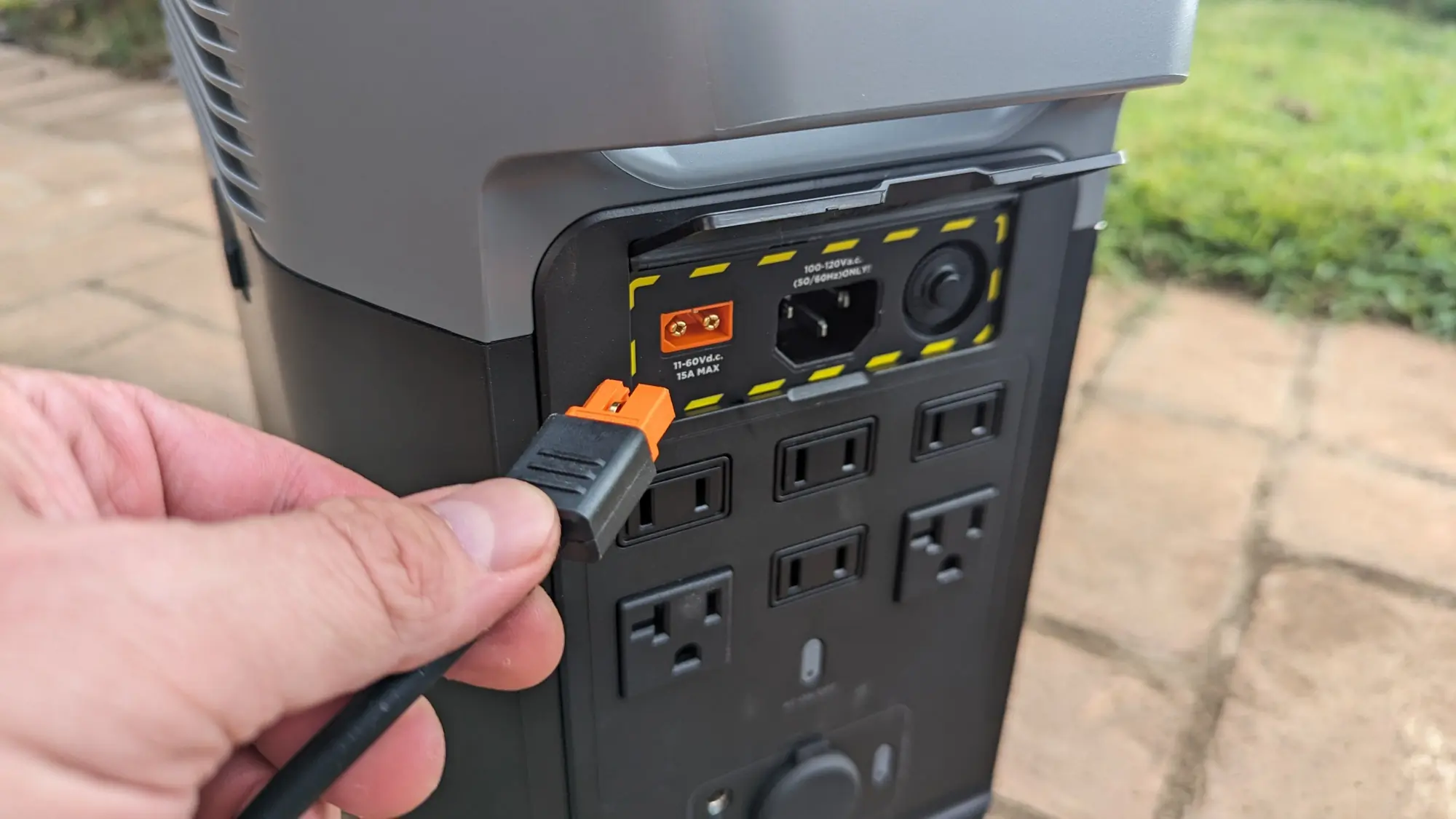



But it’s important to think about how much space you’re willing to dedicate in your pack and/or vehicle to a solar charger and where you’ll likely be using it. For instance, the GoSun Shield is too tall to stow in a backpack, but that could be fine since you’ll mostly be using it on and around your vehicle, as opposed to hiking with it. Bottom line: Pay attention to a solar charger’s dimensions when folded/packed.
Weight
Other than the EcoFlow 220W Bifacial Portable Solar Panel — the perennial outlier of this group, which weighs just north of 20 pounds — the average weight of the solar chargers we tested was just under three pounds.
As a rule, though solar panels do vary somewhat in efficiency, expect their weight to correlate to how many watts they offer. Thus, a 20W solution will probably be twice as heavy as its 10-watt counterpart. But as you’re about to see, how you’ll carry the solar charger is also a factor.
Carrying
Obviously, it’s easier to carry something with a case and/or handles, but it’s more so for the heavier, bulkier solar panels on our list. For instance, the fact that the 5-pound Outdoor Tech Dawn’s built-in handles magnetically clasp together makes it super easy to carry.
The BioLite SolarPanel 100 we tested is not only almost twice as heavy but also a little awkward to carry because we had to work harder to grasp the built-in handles together.
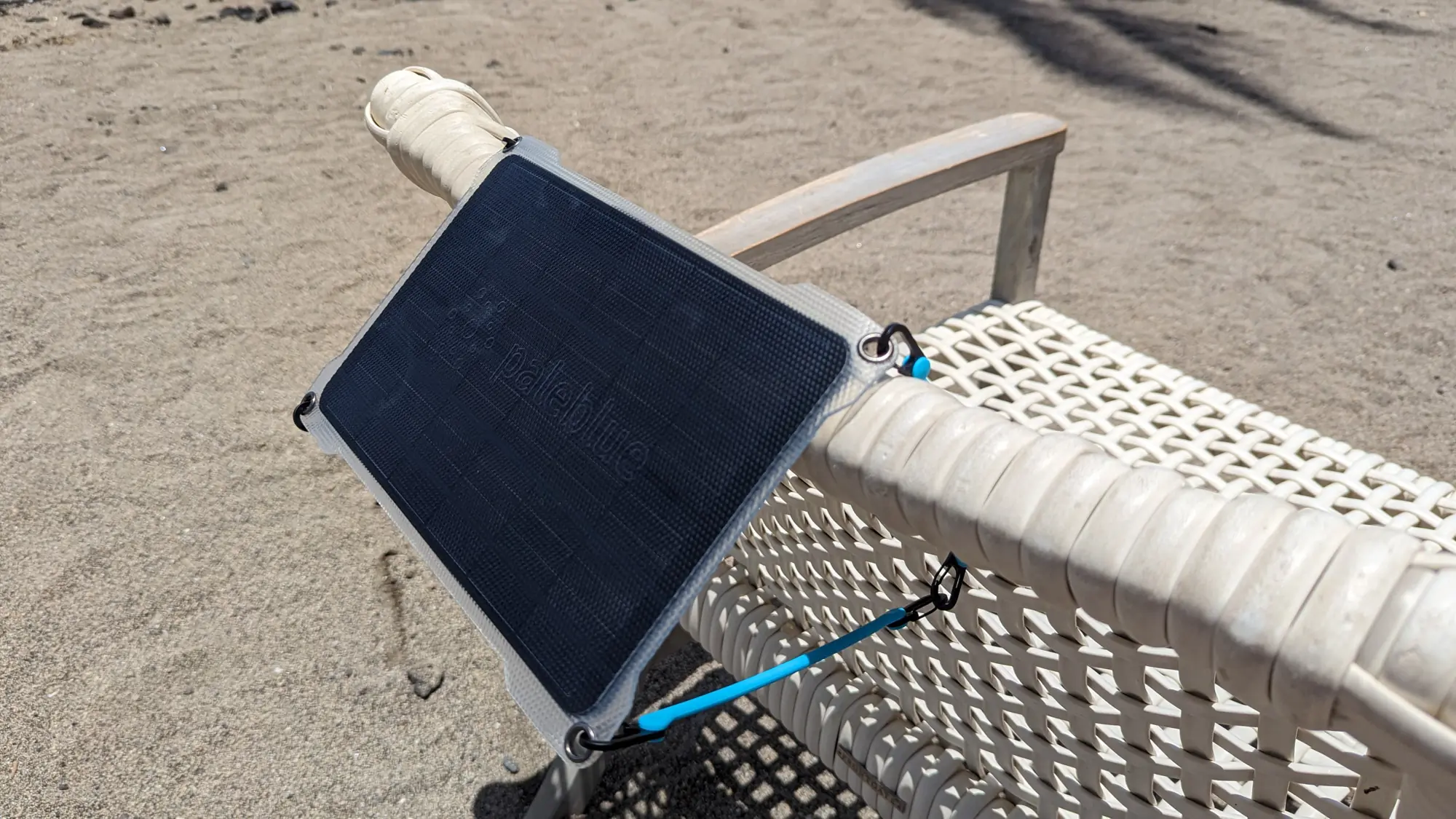



And yet, twice as heavy as that, there’s something about the weight distribution of the 21-pound EcoFlow 220W Bifacial in its case that doesn’t feel so daunting. So it’s all about how carryable the panel is, especially if you plan to haul it over a significant distance to use it.
Since, with gear, the little things can ultimately make a big difference — it’s worth mentioning that we’re fans of the solar chargers that feature webbed pouches or zippered pockets attached to them. Very handy for storing charging cables — or perhaps even the device being charged.
For instance, the single-panel version of the Pale Blue Earth Approach Portable Solar Panels doesn’t have (or need) a carrying case, but it does feature a handy pouch on the back. We used it to stash our phones, avoiding potentially damaging wet and sandy surfaces.
Positioning
How you position your solar panel is one of the three biggest factors you can control in how well it performs. So, if you’re looking to optimize how much sunlight you collect, choosing a solar charger with an adjustable stand is important. Fortunately, most of the ones we tested do.
And the ones that don’t, such as the Pale Blue Earth Approach and the panel that comes with the GoSun Solar Powered Backpack, often include holes so that they can be conveniently lashed to a backpack, tent, boat railing, or other creative rig.
Real-Time Feedback
The question remains as to how you know the panel is well-positioned. Some feature a number of colored lights that indicate whether the sun it’s collecting is stronger or weaker. Others, such as all the BioLite SolarPanel products we tested, integrate a super helpful analog sundial. The closer you line up the shadow of the painted dot, the better the panels are aligned for catching rays.
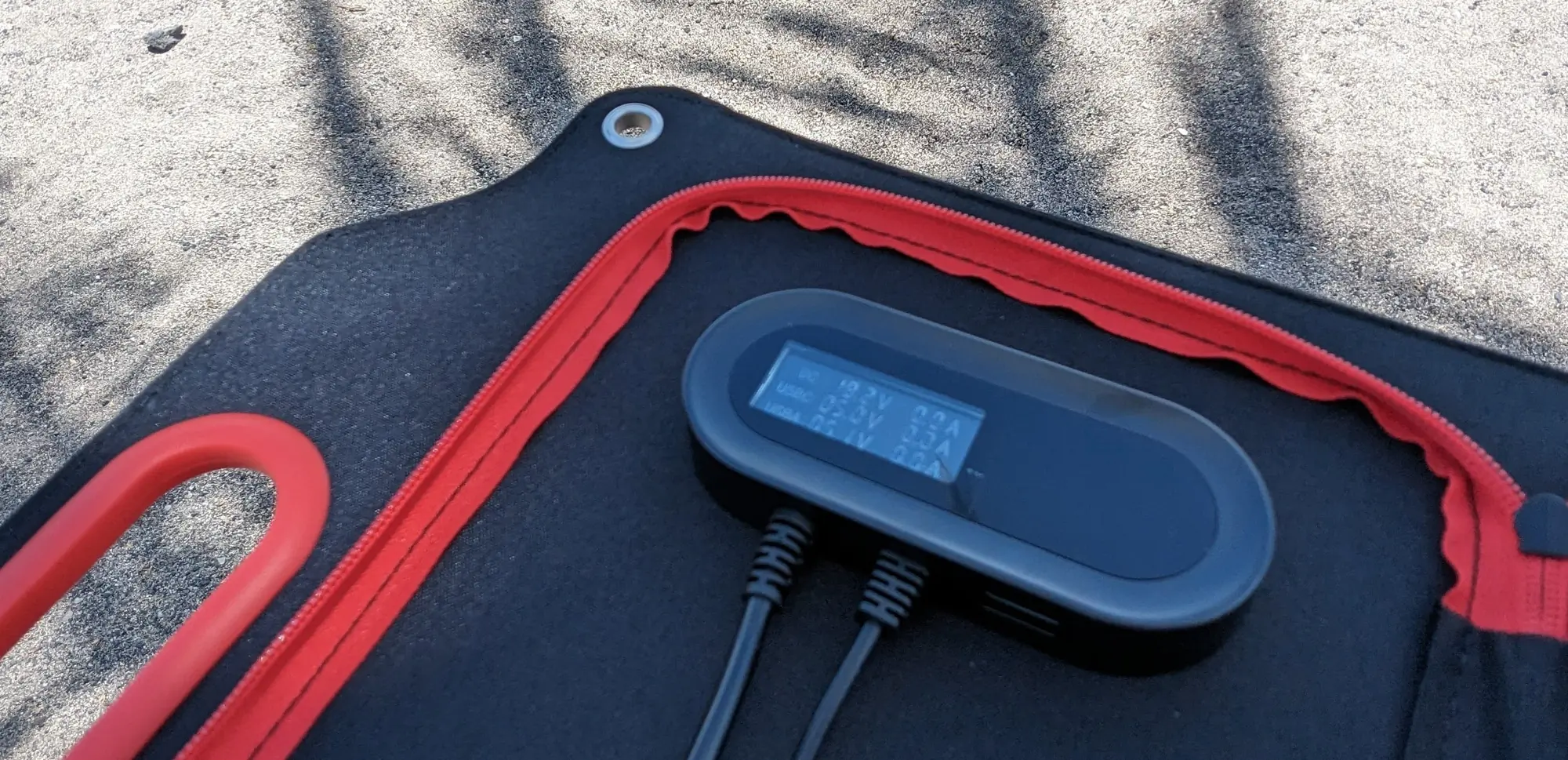



A few of the systems offer digital feedback. For instance, a readout is built into the Outdoor Tech Dawn. There’s also one built into the external batteries we used alongside the GoalZero Nomad 20 and EcoFlow 220W Bifacial. In each of these cases, we were able to track in real-time how many watts the system was pulling and make small positioning adjustments until those numbers maxed out.
Connections
To a large extent, the degree to which a solar charger can connect to other devices determines how useful it is.
Outputs
One of the big factors that drew us to the GoalZero Nomad 20 is that it features not only a USB-A port but also an integrated cable designed to charge solar-optimized power banks, such as their Sherpa 100AC. That unit has not only two USB-A ports and two power delivery USB-C ports, each capable of charging a laptop, but also an AC outlet into which you can plug small appliances. So it’s important to consider both the number and types of ports offered on the solar charger itself and an external battery if you’ll be using one.
Battery vs. Direct
In addition to offering more functionality and power when the sun’s not around, using an external battery (a power bank or portable power station) provides an extra layer of safety for your devices. Today’s batteries tend to be smarter about doling out power in a way that’s consistently safe for the mobile device on the other end, as opposed to just freewheeling it by connecting directly to the solar charger and crossing your fingers.




This is what makes solar chargers with built-in batteries appealing. Along with such obvious entries as the MPowerd Luci + Powerbank and BoomPods Neutron Power Bank, the BioLite SolarPanel 10+ features a built-in battery.
In each of these cases, the batteries act to regulate voltage in a way that protects your phone or other mobile devices from being overcharged. Some solar panels integrate controllers that do the same thing, so it’s something to pay attention to, especially on larger solar chargers.
Creating Series
Is it better to get more solar panels of a lower wattage or fewer at a higher wattage? The answer to this question depends on whether you more heavily value price or modularity. In other words, it might be less expensive — not to mention easier to transport and simpler to use — a 400W solar panel as opposed to four 100W panels. But if you usually only need a 100W panel to refill your portable power station of choice, there’s no sense lugging around a 400W beast every time.
If you decide that you do want to connect a series of solar panels, it’s easiest/best to go with the same brand, model, and wattage. That way, you can just follow the suggestions on the site about how many can be connected in a series and have peace of mind that they’ll play nicely together.
Portable Power Stations
Having said what we just did about connecting panels in series, it’s possible to mix and match solar panels from one brand with portable power stations from another. Conversely, manufacturers sometimes change their connection port types, rendering previous solar panels incompatible with newer power stations.
In either case, don’t assume that a solar panel will connect to a portable power station — with or without an adapter. Look to see what type of connection it’s sporting. For instance, MC4 is a popular kind of DC connection you might encounter. But especially if you’re purchasing a solar panel and portable power station separately, first be sure to check the physical shape and electrical compatibility of their connection.
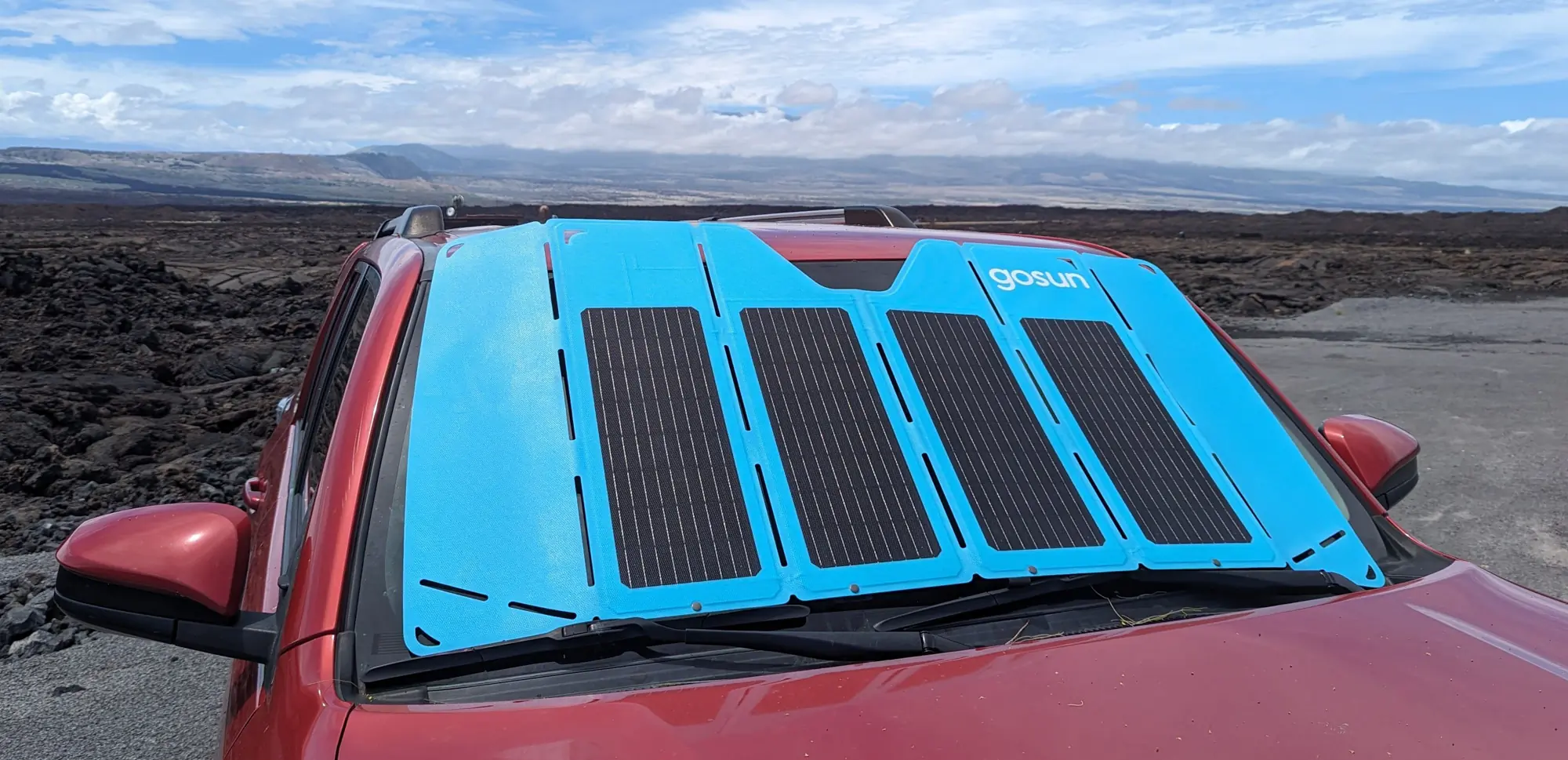



Price & Value
For what it’s worth, the average price of all the portable solar chargers we tested was around $170. But that varies wildly, along with the power and size of the chargers. To level the playing field, we calculated the price per watt. So, although the retail cost of purchasing the GoSun Shield, Outdoor Tech Dawn, and EcoFlow 220W Bifacial ranged broadly from $130 to $649, each of those costs roughly $3 per watt, but each of these comes with a few different features depending on how much you want to spend. Here’s what you get for your money.
Budget
There are plenty of portable solar power banks for under $100, but these are geared more toward powering smaller devices, and the quality can vary wildly. If you just want to keep your cell phone going during an off-grid trip, we’d recommend something like the BoomPods Neutron Power Bank ($55). Roughly the size of a cell phone, this power bank can charge two USB-powered devices at once, packs a built-in flashlight, and has a solar panel on one side that can keep it powered.
Mid-Tier
If you need a bit more juice, you can find more substantial solar charges in the $100 to $200 range. The Outdoor Tech Dawn Solar Panel ($130) can pump out 40 watts of power It is easy to carry thanks to its integrated handles and magnetic clasps, and its built-in pouch carries an integrated USB-C cord, two DC cords, and a standard USB-A port as well.
Premium
As with most tech-y gear, the sky’s the limit when it comes to price. Our top pick, the EcoFlow 220W Bifacial Portable Solar Panel ($649) is the biggest and most powerful solar charger on our list, with a whopping 220-watt power output. It also has solar cells on both sides of the solar panel, which means that, in addition to getting power directly from the sun, the panel can also absorb reflected sunlight from the ground.
Frequently Asked Questions
Not usually. The wattage quoted is its maximum power output under ideal (i.e. laboratory, not real world) conditions. In a “normal” scenario, even in direct sunlight, you might expect a solar panel to pump out 25 to 75 percent of its wattage rating.
The external factors that greatly affect solar performance include the part of the world you’re in, the season and time of day, cloud cover, shade, any dirt or other objects on the panel, and the outdoor air temperature. In other words, it’s very easy not to have ideal conditions. So couch your expectations accordingly.
Yes. As anyone who’s ever gotten sunburned on an overcast day can attest, the sun’s rays are still beaming through, even if it’s not clear and bright. Solar panels are built to collect those rays despite the dreary conditions. In fact, some can even snag power from indoor light, though it’s a tiny fraction. Bottom line: Solar panels work best on bright, sunny days.
There are three main factors that you can control. First, keep the solar panel as clean as possible. Second, position the panel so that no part of it is in the shade. And third, monitor the panel’s tilt throughout the day. For instance, you may want to adjust the panel in the late morning and mid-afternoon as the sun’s position changes.
Although apps and sites with fancy calculators will tell you the exact optimal solar panel angle at any time based on your precise location, that’s not very practical for portable solar chargers. The easiest solution is a good old-fashioned analog sundial, such as the ones built into the EcoFlow 220W Bifacial and the entire BioLite SolarPanel line.
To varying degrees, yes. Be sure to check out a solar panel’s Ingress Protection rating. The first number relates to dust. If it’s a 5 or 6 (i.e., IP53 or IP68), that means the solar panel is protected against dust, which is helpful to know if you’re in a windy mountain or desert location.
The second number has to do with liquids. If it’s a 4 through 6 (i.e., IPX4, IP65), you don’t have to worry about splashes or rain. The ones marked IP67 and IP68 are totally waterproof and theoretically able to be safely submerged.
Yes. This is a common feature in solar panels rated for 100 W and higher. Typical use cases for panels of that size are overlanding, RVing, and glamping, situations where you want to be able to scale up your solar charging capabilities based on the demand of a particular expedition.
Although it is possible to create an array made from different products that feature identical voltage and current ratings, the safest way to go if you’re creating a series of solar panels is just to hook up multiple iterations of the exact same product.
Yes, if you plug your device directly into the solar panel. The difference between watts and volts is important, especially for phones and other small devices charged via USB. Today’s small devices can handle a higher wattage charger but not higher voltage (more than 5 V for most phones).
On the flip side, not having enough wattage either won’t charge your laptop or, if it does, may damage its battery. That’s why it’s safer to use solar panels with built-in controllers or batteries that regulate the outgoing voltage.
Or, even better, use your solar panel to charge an external battery (or portable power station) designed to receive solar input, such as the GoalZero Sherpa 100AC power bank we tested, and then use that battery to charge your devices safely.


No Battery, No Problem: Box Synergy Solar 7 Charger Folds to Fit in Your Pocket
Box Synergy’s Solar 7 Panel not only performed great in testing, but it also stands out from others on the market. Read our full review.
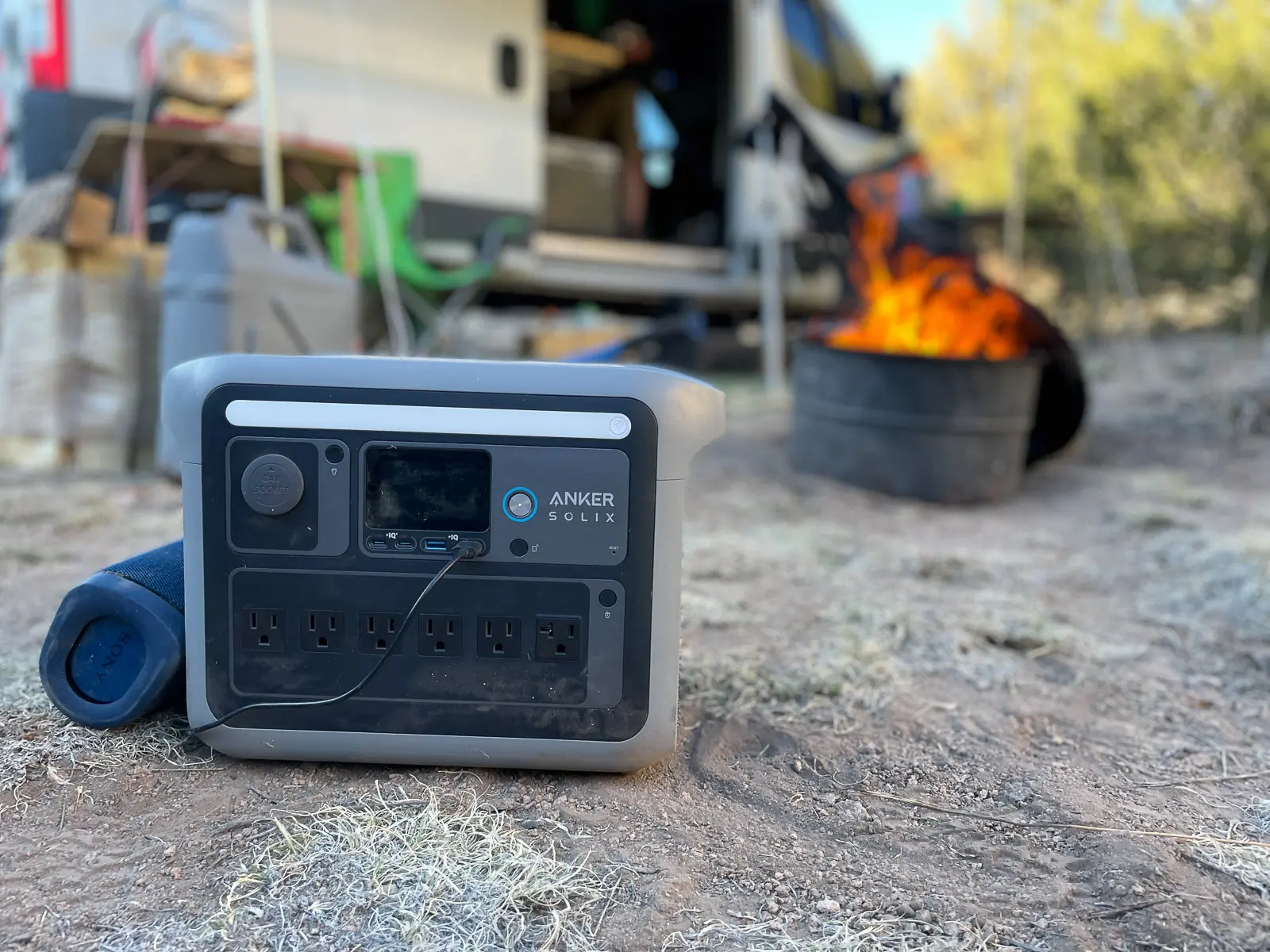

The Best Portable Power Stations of 2025
A good portable power station will keep you off the plug for days or even weeks at a time. We’ve tested the latest, including Anker, Goal Zero, and more.
